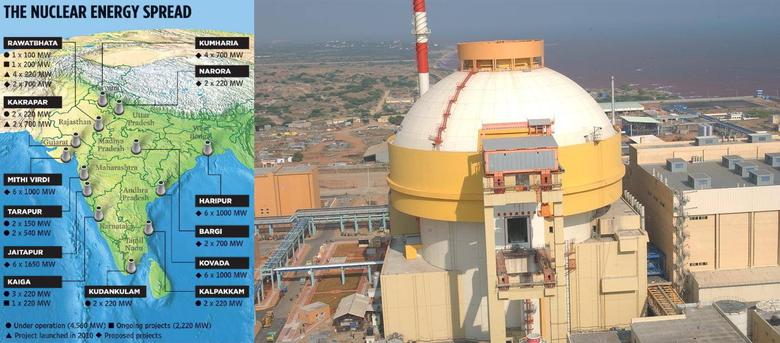
21 REACTORS FOR INDIA

NBN - Nuclear power is the largest source of electricity in India after thermal power, hydropower, and renewable energy. India has a low domestic uranium reserve and relies on uranium imports to support the nuclear power industry. Therefore, since 1990, Russia has been a significant supplier of nuclear fuel to India.
Nuclear Power Corporation of India Limited (NPCIL) operates the 1400 MW boiling water reactor and pressurized heavy water reactor in Tarapur (Maharashtra), 2000 MW is installed at Kudankulam (Tamil Nadu). Heavy water reactors with a capacity of 880 MW are located at Kaiga (Karnataka), 440 MW at Kakrapar (Gujarat), 1180 MW at Rawatbhata (Rajasthan), 440 MW at Kalpakkam (Tamil Nadu) and 440 MW reactors at Nonera (Uttar Pradesh). The availability factor of 9 nuclear power stations in the country has been 90 percent.
The rapid growth of nuclear in India is illustrated by the construction of 21 nuclear reactors to increase the power generation to 15,7 GW by 2031 in Mahi Banswara, Gorakhpur, Kudankulam, Rawatbhata, Kakrapar, Chutka-Madhya, and Kalpakkam (Fast Breeder).
Rawatbhata is going to become the center of the second dominant nuclear power generation on the banks of the Chambal river in the southeast of Rajasthan.
The Atomic Energy Commission, set up in 1948 to formulate policies for the peaceful use of nuclear energy, established the Department of Atomic Energy in 1954 to implement the strategies. Since its inception, the Department of Atomic Energy has been continuously working in this direction. The Bhabha Atomic Research Center operates under this department in Mumbai in Maharashtra State, the Indira Gandhi Atomic Research Center in Lakpakkam in Tamil Nadu State, the Advanced Technology Center Indore, the Variable Energy Cyclotron Center in Kolkata and the Directorate of Atomic Exploration and Research in Hyderabad.
The Department of Atomic Energy provides financial assistance to seven institutes, including the Tata Fundamental Research Institute (Mumbai), the Tata Memorial Center (Mumbai), the Saha Institute of Nuclear Physics (Kolkata), the Institute of Physics (Bhubaneswar), the Harishchandra Research Institute (Allahabad), the Institute of Mathematical Sciences (Chennai) and the Plasma Research Institute (Ahmedabad).
-----












